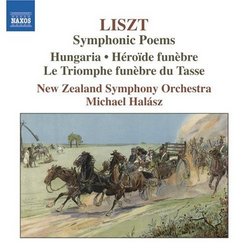| All Artists: Franz Liszt, Michael Halasz, New Zealand Symphony Orchestra Title: Liszt: Symphonic Poems Members Wishing: 0 Total Copies: 0 Label: Naxos Original Release Date: 1/1/2006 Re-Release Date: 1/30/2007 Genre: Classical Styles: Forms & Genres, Symphonies, Theatrical, Incidental & Program Music, Symphonies Number of Discs: 1 SwapaCD Credits: 1 UPC: 747313284726 |
Search - Franz Liszt, Michael Halasz, New Zealand Symphony Orchestra :: Liszt: Symphonic Poems
 | Franz Liszt, Michael Halasz, New Zealand Symphony Orchestra Liszt: Symphonic Poems Genre: Classical
|
Larger Image |
CD DetailsSimilar CDs |
CD ReviewsChips from Liszt's Tone-Poem Workbench J Scott Morrison | Middlebury VT, USA | 02/13/2007 (4 out of 5 stars) "If I'm not mistaken this is the fourth in the series of recordings by Michael Halasz and the New Zealand Symphony Orchestra of tone poems by Liszt, the putative creator of that musical form. In truth, the only one we hear much these days, and it is not heard nearly as much as it was fifty years ago, is 'Les Préludes.' On this recording we have three tone poems that are almost never played. It is not that they are without merit. But they would need to be better, I fear, to edge into the modern orchestral repertoire. Still, it's good to hear them, especially in these marvelously alive and lush recordings by the NZSO, fortunately a much-recorded orchestra these days thanks to the Naxos label.
'Hungaria' (1856) was premiered in Pest while Liszt was there for the reconsecration of a cathedral. In its twenty-two minutes it features a funeral march, which returns later in the work, a dramatic march with blazing brass, a melancholy section with double-reed plangency, and finally an 'Allegro trionfante.' The work brims with memorable melodies and creative orchestration; it had been sketched in the fateful year of 1848 when all of Europe, including Hungary, was in revolt. The Hungarian uprising was cruelly put down by the Habsburg rulers and surely that is the occasion for so much of the funereal quality of the music. Consequently, one can assume that the 'triumphant' finale is more optimistic than commemorative. 'Héroïde funèbre' (also known as 'Heldenklage') was originally sketched in 1830 (!) but finished in 1854 (with some help from his student, Joachim Raff). It was supposed to be a movement from a planned 'Revolutionary Symphony' that, as it happens, never got written. There is a good deal of dramatic and funereal music. The most memorable part of the work is a solemn and beautiful chorale in the middle of the piece. Liszt wrote several versions of works about Tasso, the sixteenth-century Italian poet imprisoned for daring to fall in love with his patron's sister. Goethe wrote a famous play and in 1849 Liszt wrote his initial Tasso piece for the centenary of Goethe's birth. The work on this disc, 'Le Triomphe funèbre de Tasso', was written in 1866, the third of Liszt's so-called 'Trois odes funèbres'. A major part of the tone-poem is the repeated use of a melody Liszt had heard Venetian gondoliers singing to one of Tasso's most famous lines from Gerusalemma Liberata. Interestingly, this work was premiered in New York City in 1877 by its dedicatee, Leopold Damrosch, conductor of the New York Philharmonic. In arch form, it begins as a funeral march but leads to a triumphal section which then descends back into sadness at the conclusion. These are not major works, but they are worth hearing. And the performances and the recording are first-rate. Scott Morrison" |

 Track Listings (3) - Disc #1
Track Listings (3) - Disc #1
